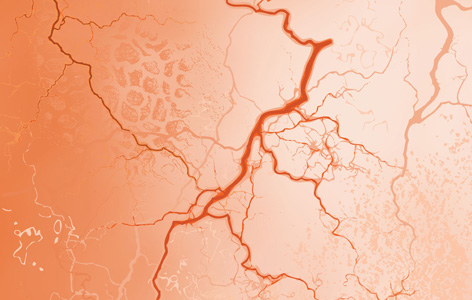Home page Description:
Research reveals how one biomaterial accelerates wound healing.
Posted On: September 07, 2016

Image Caption:
Diabetes damages blood vessels (pictured) and prevents adequate oxygenation of tissue, which creates an unfavourable environment for wound healing.
Wound healing is a fragile and complex process. It occurs through a series of ordered stages that begin within minutes of injury. First the blood clots, then damaged cells are cleared out, new tissues grow and mature, and finally cells that are no longer needed are removed. If the progression of these stages is disrupted—as is commonly seen in individuals with diabetes—the wound becomes chronic and fails to heal.
TGHRI Affiliate Scientist Dr. Michael Sefton has developed a biomaterial to optimize the wound-healing process in patients with diabetes. The material consists of beads made from a compound known as methacrylic acid (MAA). His team previously showed that the beads accelerate wound closure in experimental models of diabetes; however, they were unable to uncover how the beads worked because several functions, including blood circulation and tissue growth, are severely impaired in the diabetic environment.
The team has now developed a model to investigate the effects of the beads without the confounding factors of diabetic wound healing. Using this model, they found that MAA beads increase blood vessel growth—which is critical for wound healing—by activating a pathway that regulates tissue regeneration known as the sonic hedgehog signalling pathway. The beads also promote healing by attracting and promoting the growth of specific immune cells (macrophages) that are involved in blood vessel maturation.
Explains Dr. Sefton, “These discoveries reveal that our model is useful for evaluating new approaches to promote wound healing in diabetic and other patients. Our next steps will be to use this model to refine the composition of the beads and optimize their ability to promote wound healing.”
This work was supported by the Ontario Research Foundation, the Natural Sciences and Engineering
Research Council, the Province of Ontario, the University of Toronto and the Canadian Institutes of Health Research.
Effect of methacrylic acid beads on the sonic hedgehog signaling pathway and macrophage polarization in a subcutaneous injection mouse model. Lisovsky A, Zhang DK, Sefton MV. Biomaterials. doi:10.1016/j.biomaterials.2016.04.033. 2016 Aug [Pubmed abstract]
TGHRI Affiliate Scientist Dr. Michael Sefton has developed a biomaterial to optimize the wound-healing process in patients with diabetes. The material consists of beads made from a compound known as methacrylic acid (MAA). His team previously showed that the beads accelerate wound closure in experimental models of diabetes; however, they were unable to uncover how the beads worked because several functions, including blood circulation and tissue growth, are severely impaired in the diabetic environment.
The team has now developed a model to investigate the effects of the beads without the confounding factors of diabetic wound healing. Using this model, they found that MAA beads increase blood vessel growth—which is critical for wound healing—by activating a pathway that regulates tissue regeneration known as the sonic hedgehog signalling pathway. The beads also promote healing by attracting and promoting the growth of specific immune cells (macrophages) that are involved in blood vessel maturation.
Explains Dr. Sefton, “These discoveries reveal that our model is useful for evaluating new approaches to promote wound healing in diabetic and other patients. Our next steps will be to use this model to refine the composition of the beads and optimize their ability to promote wound healing.”
This work was supported by the Ontario Research Foundation, the Natural Sciences and Engineering
Research Council, the Province of Ontario, the University of Toronto and the Canadian Institutes of Health Research.
Effect of methacrylic acid beads on the sonic hedgehog signaling pathway and macrophage polarization in a subcutaneous injection mouse model. Lisovsky A, Zhang DK, Sefton MV. Biomaterials. doi:10.1016/j.biomaterials.2016.04.033. 2016 Aug [Pubmed abstract]




